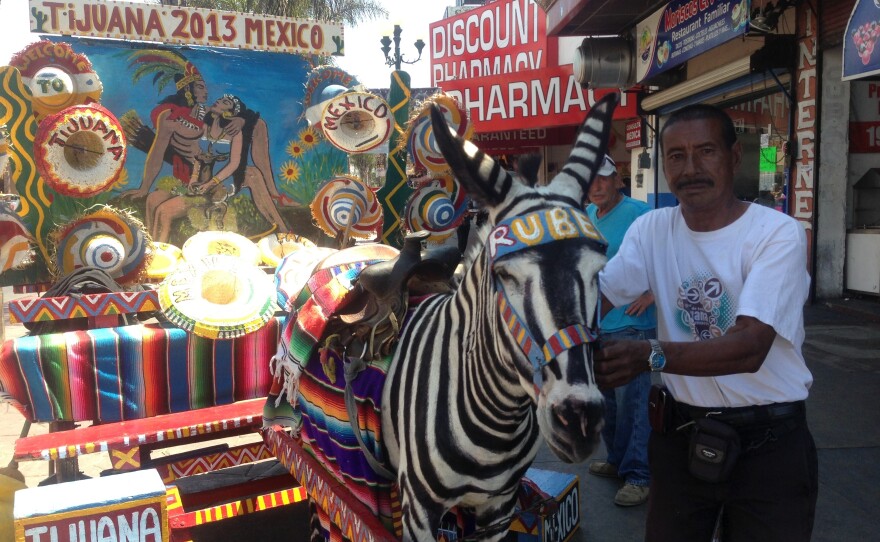

Ruben prances across the street one recent morning on his way to work on a corner of Tijuana's famous tourist strip, Avenida Revolución.
Ruben's hair is freshly dyed. His nametag is shiny.
But both he and his boss, Victor Reyes, have long faces.
Ruben, well, he's a donkey, (a "zonkey" in local parlance).
As for Reyes, his business -- taking photos of tourists atop Ruben -- has stumbled on hard times.
'Old Mexico'
Back in the 1960s, Reyes says, the American tourists coming into this westernmost Mexican city, just south of San Diego across the California border, lined up for the chance to have a picture taken atop one of the donkeys painted to look like zebras.
Tijuana had been a tourist destination for a century, says Josúe Beltrán, a professor of history at the Autonomous University of Baja California. Beltran says the American tourists would drink, gamble, visit prostitutes, and look for "old Mexico." The donkeys filled that bill.
Photographers trotted them out as a representation of old times, throwing serapes over the shoulders of Americans dressed in long dresses and heavy suits. They'd stand next to the donkey or climb on top.
The only problem was the white donkeys didn't show up well in black and white photos. Just a little ear and nose.
Photographers began to experiment, and it occurred to someone to paint stripes so they'd show up. And so they did with women's' hair dye.
'Zonkey' Fever
For decades, business boomed.
Tijuana's basketball team was named "The Zonkeys". The city began to use stripes in its logo.
But the Sept. 11, 2001, terrorist attacks changed all that. Security lines at the U.S. border became interminable.
Then the recession hit. Then the drug war.
People became fearful to even step a toe into Tijuana.
The number of donkeys shrank from 25 to three.
On a recent afternoon on Avenida Revolución, a lone mariachi band crooned to about a dozen tourists and hundreds of empty bar chairs.
Reyes has settled in atop a plastic bucket.
He thumbs through the newspaper next to Ruben, until some tourists from Texas arrive, only his third customers all day.
Tourist Sue Robel say she was excited to take a picture with her granddaughter, Amber Ivy.
"My mom and dad were here in the '40s. And they have a picture, not with a zebra, but with a donkey. And so it's like, 'OK, let's do it,'" says Robel.
Tijuana's Cultural Heritage
Roberto Lango, who runs a marketing firm, leads a group of concerned citizens who want to keep this tradition from going extinct. He says he grew up seeing striped donkeys, and he wants his grandchildren to see them, too.
In September, Lango will ask the State of Baja California to protect the "zonkeys" as part of Tijuana's cultural heritage.
He wants photographers to get on the state's payroll, "zonkeys" at all big civic events, and iPads for the tourist photographers so they can post photos directly to Facebook and Twitter.
He says Tijuana's "zonkey" business may have to modernize, but it will not change its stripes.
Copyright 2013 NPR. To see more, visit www.npr.org.






